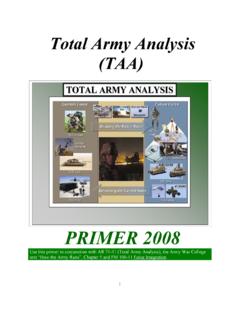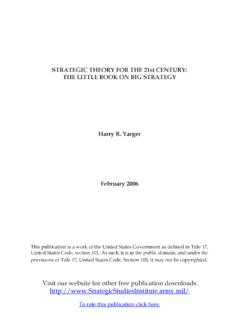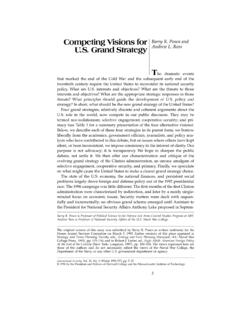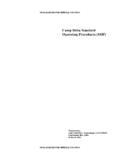Transcription of Total Army Analysis - comw.org
1 1 Total army Analysis (TAA) PRIMER 2005 Use this primer in conjunction with AR 71-11 ( Total army Analysis ), the army War College text How the army Runs , Chapter 5 and FM 100-11. Total army Analysis (TAA) 2 I. Force Development Process (overview) 1. Force development is the start point, rationale and underlying basis for defining the army s force structure. The Force Development Process consists of defining military capabilities, designing force structures to provide these capabilities, and translating organizational concepts based on doctrine, technologies, materiel, manpower requirements, and limited resources into a trained and ready army . The five phases are: a.
2 Develop Capabilities b. Design Organizations c. Develop Organizational Models d. Determine Organizational Authorizations e. Document Organizational Authorizations 2. The five phases of the force development process are displayed in the chart (figure 1). This model reflects a sequence of events and how these functions relate to each other. The resulting products of force development provide the basis for acquiring and distributing materiel and acquiring, training, and distributing personnel in the army . It is useful to use the army Force Development Process to visualize how each step relates to the other steps and contributes to the accomplishment of each task. a. Develop capabilities. The force development process has its roots in the Joint Capabilities Integration and Development System (JCIDS). A separate primer (Materiel System Research, Development and Acquisition Management) discussing the JCIDS can be found on the army Force Management School web site.
3 The JCIDS identifies the desired operational capability in terms of personnel, equipment, and unit structure. This process begins RecommendedAuthorized Quantities Recommendation to Resource OrganizationalAssessments Alternatives Combatant Cdr IPLs Organizational Rqts FMS TAEDP TAV TAA PBG/MDEP MACOMs Combatant Cdr IPLsForce Design Division Human Resources CMDC ombat /Materiel Developer Schools / ProponentsMACOMs Force Development ProcessForce Development ProcessApply Rules / Standards / Guidance to Develop Organization ModelsDetermine / Verify Affordability, Supportability,ExecutabilityINPUT:USAFMS AUSASOC URSURS BOIPFD/BOIP (Existing) DA PAM 611-21 SB 700-20 (Supply Bulletin) AR 71 - 32 (FD & Doc.) FM Bulletin Board OPFAC RulesOI TEAMO rganizational RequirementsRecommended AuthorizedQuantities Combatant CommandersMACOMsBattle LabsSchool / ProponentsINPUT:Current Force StructureCapability GapsFunctional Solution AnalysisOUTPUT:PHASE 1 PHASE 4 PLAYERSPLAYERSPLAYERSA pply Doctrine (or otherBaseline) to Develop Organization DesignsINPUT:OUTPUT:FDUR equiredCapabilitiesDOTMLPFPLAYERSPHASE 2 DESIGN ORGANIZATIONSDEVELOP ORGANIZATIONAL MODELSDETERMINE ORGANIZATIONAL AUTHORIZATIONSG-37 (FM)USAFMSAR eview, Approve &Document AuthorizedQuantities INPUT:TAADSTAADSUIC Specific Authorizations DocumentPHASE 5 PLAYERSDOCUMENT ORGANIZATIONAL AUTHORIZATIONSG enerate Capabilities from DOTMLPFREQUIRED CAPABILITIESD octrine - DLMPO rganizations FDUT raining - SAT/TRASM ateriel LCSMML eadership & EducationPersonnelFacilitiesDEVELOP CAPABILITIES PHASE 3 INPUT:OUTPUT:OUTPUT:OUTPUT.
4 O&O Plan / CDDBOIP/TOEURS / CDDDAA pprovalARSTRUCDAA pprovalDAApprovalDAApprovalPERSACSLOGSAC SA pproved DesignAcronym list: ARSTRUC: army Structure Message BOIP: Basis of Issue Plan BOIPFD: BOIP Feeder Data CDD: Capability Development Document DLMP : Doctrine and Literature Master Plan FDU: Force Design Update FMS: Force Management System G-37(FM): Force Management ICD: Initial Capabilities Document IPL: Integrated Priority List LOGSACS: Logistics SAC MACOM: Major Command MDEP: Management Decision Package OI: Organization Integrator OPFAC: Operational Facilities PBG: Program Budget Guidance PERSACS: Personnel SACS SACS: Structure and Composition System SAT: Systems Approach to Training TAA: Total army Analysis TAADS: The army Authorization Documentation System TAEDP: Total army Equipment Distribution Plan TAV: Total Asset Visibility TOE: Table of Organization and Equipment TRAS: Training Requirements Analysis System UIC: Unit Identification Code URS: Unit Reference Sheet USAFMSA: Unite States army Force Management Support Agency USASOC: army Special Operations Command 3 with the receipt of national-level guidance (National Security Strategy (NSS), National Military Strategy (NMS), Quadrennial Defense Review (QDR), and Strategic Planning Guidance (SPG) and Joint Programming Guidance (JPG), guidance from the army s senior leadership (The army Plan (TAP)), joint warfighting concepts (such as rapid decisive operations, peace enforcement operations), and/or new materiel capabilities evolving from the research, development, and acquisition (RDA) process.)
5 The focus of JCIDS is to resolve identified capabilities gaps, perceived deficiencies or shortcomings in the current force. The objective of JCIDS is to develop solutions that are affordable, militarily useful, and supportable to the combatant commanders (COCOM). JCIDS develops integrated, joint capable solutions within the domains of DOTMLPF (doctrine, organizational structure, training, materiel, leadership and education, personnel and facilities). The process examines where we are, where we want to be, what risks we may face and what it might cost. The Analysis process is composed of a structured, four-phased methodology that defines capability gaps, and capabilities needed to resolve the problem. army Training and Doctrine Command (TRADOC Futures Center) assesses the future warfighting concepts through a series of analyses, tests, experiments and studies to gain insights across DOTMLPF. Using the integrated concept team (ICT) management technique, TRADOC pursues timely involvement of appropriate agencies/expertise to aggressively identify and work issues.
6 TRADOC establishes force operating capabilities (FOCs) as the foundation upon which to base the assessment process. These critical, force-level, measurable statements of operational capability frame how the army will realize advanced full spectrum operations as stated in the approved capstone concept. The FOCs focus the army s Science and Technology Master Plan (ASTMP) and warfighting experimentation. As the transformation process unfolds, these force-level objective concepts will give rise to supporting proponent/branch future FOCs included within subordinate concepts. This assessment process leads to a recommendation by the Commanding General (CG), TRADOC to Headquarters, Department of the army (HQDA) on how to best fulfill the warfighting requirement. If the capability requires a change in doctrine, training, or leader development, TRADOC begins action to meet the requirement upon validation by the HQDA Deputy Chief of Staff (DCS), G-3/5/7 and approval by the Chief of Staff, army (CSA).
7 If the solution set results in a need for change in soldier occupational specialty structure, the recommendation goes forward to HQDA DCS, G-1 for action. If the required capability needs a materiel solution, TRADOC prepares the initial capabilities document (ICD) and a capability development document (CDD) and forwards them to HQDA DCS, G-3/5/7 for approval of the requirement through the army Requirements Oversight Council (AROC) validation/approval process. HQDA DCS, G-8 is responsible for materiel solutions and DOTMLPF integration through out the program life cycle. Warfighting concepts requiring organizational solutions move to the next phase of force development. b. Design organizations. The DESIGN ORGANIZATIONS PHASE provides the organizational solution to DOTMLPF. This Phase analyzes the proposed organization for doctrinal correctness. It provides a forum for the entire army to review the issue and links the Combat, Materiel, Training and Document Developer together.
8 Organizational requirements flowing from the Functional Solution Analysis (FSA) determine whether a new or modified organization is required on tomorrow s battlefield to satisfy the capability gap identified in the Develop Capabilities Phase. Once identified, organizational requirements are documented through a series of connected and related organizational development processes: Unit Reference Sheet (URS) development; Force Design Update (FDU) process; Table of Organization and Equipment (TOE) development; and Basis-Of-Issue Plan (BOIP) development. 4 When DOTMLPF Analysis selects a new or improved organization as the best solution, the combat development communities in TRADOC or the other proponents document proposed organizations or modification to existing organizations on a unit reference sheet (URS). The URS specifies the organization s mission and functions as well as outlining required personnel and equipment.
9 TRADOC s Force Design Division (FDD) at FT Leavenworth takes the URSs from the proponents and tracks them through the staffing and approval process in force the design update (FDU). In the FDU process, we take good ideas from a variety of sources, develop army -wide consensus through staffing, and forward them through HQ, TRADOC to HQDA. The CSA/VCSA simultaneously approves both its design and its army -wide implementation. URSs contain sufficient detail (unit title, design description, mission, assignment, tasks, assumptions, limitations, mobility requirements, and concept of operations) to support army force design initiatives, and related studies and analyses. Once approved, the URS is further refined into an organizational model known as a table of organization and equipment (TOE). c. Develop organizational models. The army Force Management Support Agency (USAFMSA) applies rules, standards, and guidance to the doctrinally correct design producing the organizational model (TOE).
10 The army Special Operations Command develops Special Operations organizational designs. The TOE is a requirements document, and is the definition of a fully mission-capable organization. It prescribes an organization s doctrinal wartime mission, its organizational structure and detailed personnel and equipment requirements. When DOTMLPF Analysis mandates a materiel solution, the proponents form an Integrated Concept team (ICT), and the materiel developer forwards data on the new equipment to USAFMSA in a basis of issue plan feeder data (BOIPFD). The data is developed into a BOIP (also a requirements document), which is applied to appropriate TOEs to add or modify equipment and/or personnel requirements. d. Determine organizational authorizations. The Total army Analysis (TAA) process is used by HQDA to determine organizational authorizations. TAA is discussed in detail in Sections III through VIII of this primer. TAA develops the Total requirements and then the authorizations defining the force structure the army must build, raise, provision, sustain, maintain, train and resource to meet OSD / army guidance, combatant commanders requirements and force structure initiatives.





